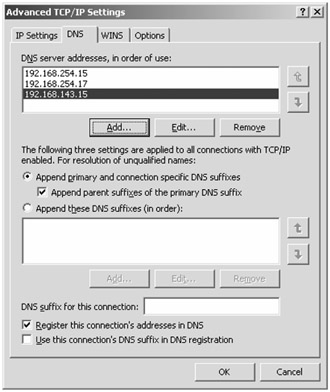Supporting Infrastructure Redundancy
Exchange servers depend heavily on the ability to access domain controllers and global catalog servers. Exchange must locate these resources on the network using DNS. For this reason, it is imperative that any organization with more than one domain controller makes sure that more than one domain controller is configured as a global catalog server.
Microsoft's "formula" for determining how many domain controllers/global catalog (DC/GC) servers are required to support Exchange is one DC/GC CPU for each four Exchange CPUs. So an organization supporting 750 users on a single-dual processor Exchange server would require only a single DC/GC. This obviously would provide no redundancy. Plus, this formula is assuming dedicated DC/GCs for Exchange.
We recommend an alternate formula that is a little more complex, but more effective:
-
Start with the minimum number of DC/GCs you require for basic directory services and authentication functions within your network. For an organization with 750 users, we would recommend two DC/GCs.
-
Add additional DC/GCs based on Microsoft's formula for calculating the additional DC/GCs required to support Exchange.
Using this formula, our 750 user, single Exchange server network would have a minimum of three DC/GCs. You should follow this formula for any physical location that has an Exchange server. Any physical location that has an Exchange server should also have a minimum of two DC/GCs.
We also recommend using the Windows Server 2003 DNS server and ensuring that the Active Directory DNS zones are configured as Active Directory-integrated zones. All DC/GCs on the network should have the Windows Server 2003 DNS service installed. The DNS zone should be configured to replicate to all DNS servers in the entire forest (not just the domain).
All Exchange servers should be configured to use at least two DNS servers for name resolution. On networks with more than two DNS servers, you should configure a primary, secondary, and a tertiary DNS server. This can be done on the Advanced TCP/IP Settings property page (see Figure 15.11).

Figure 15.11: Configuring more than two DNS servers for a Windows server
In the example in Figure 15.11, the server has been configured with a primary and a secondary DNS server; these are the DNS servers in the local Active Directory site. The third DNS server that is configured is a DNS server in a remote site. This would be queried only if the local DNS servers could not return a response to a query.
EAN: 2147483647
Pages: 198